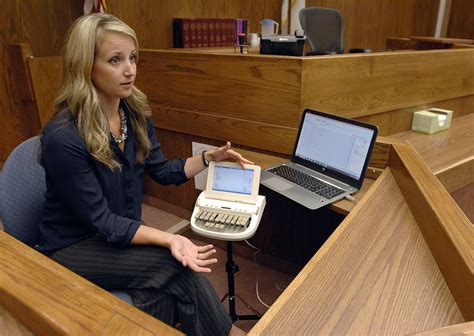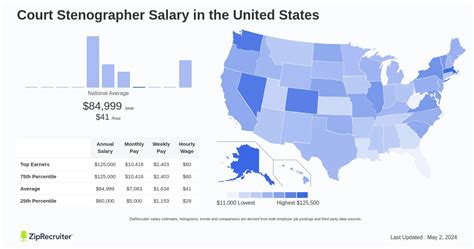For those with lightning-fast fingers, an exceptional ear for language, and an unwavering attention to detail, a career as a courtroom stenographer—also known as a court reporter—can be both intellectually stimulating and financially rewarding. As the silent guardians of the official record, these professionals play an indispensable role in the justice system. But what does that responsibility translate to in terms of salary?
While the path requires intense training and skill, the earning potential is significant. A courtroom stenographer's salary can range from a solid starting wage to well over six figures for experienced specialists. This guide will break down the numbers, explore the key factors that dictate your income, and provide a clear picture of what you can expect to earn in this dynamic field.
What Does a Courtroom Stenographer Do?

Before diving into the salary specifics, it's important to understand the role. A courtroom stenographer creates a verbatim, real-time transcript of legal proceedings, including trials, depositions, and hearings. Using a specialized stenotype machine, they type a form of phonetic shorthand at speeds exceeding 225 words per minute.
Their responsibilities go beyond just typing. They are responsible for:
- Capturing every spoken word, gesture, and action during a legal proceeding.
- Reading back testimony upon a judge's or attorney's request.
- Preparing, editing, and certifying the final, official transcript, which becomes the legal record of the event.
- Providing real-time captioning services for judges, lawyers, or jury members who may be deaf or hard-of-hearing.
It is a high-pressure, zero-error job that forms the bedrock of the judicial process.
Average Courtroom Stenographer Salary

To get a clear understanding of earning potential, we turn to authoritative data.
According to the U.S. Bureau of Labor Statistics (BLS), the median annual wage for court reporters and simultaneous captioners was $65,110 as of May 2023. A median salary means that half of the workers in the occupation earned more than that amount, and half earned less.
However, this single number doesn't tell the whole story. The salary range is quite broad, reflecting differences in experience, location, and specialization:
- Lowest 10%: Earned less than $36,250
- Highest 10%: Earned more than $111,760
Salary aggregators provide a similar picture. Salary.com reports that the median salary for a Court Stenographer in the U.S. is approximately $70,550, with a typical range falling between $59,330 and $83,430. Payscale notes an average base salary of around $58,000, emphasizing that this can be significantly augmented by page rates and freelance work.
This wide range highlights a key truth: your salary as a stenographer is not fixed. It is directly influenced by a combination of crucial factors.
Key Factors That Influence Salary

Your earning potential is a direct result of your skills, choices, and environment. Here are the primary factors that will shape your salary throughout your career.
###
Level of Education and Certification
While a bachelor's degree is not typically required, specialized postsecondary training is essential. Most stenographers complete a certificate or associate's degree program from a community college or dedicated court reporting school.
More importantly, professional certifications are a major driver of higher pay. The National Court Reporters Association (NCRA) offers several key credentials that signal a higher level of skill and professionalism:
- Registered Professional Reporter (RPR): This is the foundational certification, demonstrating a core competency that many employers require.
- Certified Realtime Reporter (CRR): This advanced certification is for those who can provide instantaneous, high-quality transcription. Professionals with a CRR can command significantly higher rates, especially in freelance and deposition work.
- Certified Broadcast Captioner (CBC) and Certified CART Provider (CCP): These certifications open doors to specialized, high-demand fields outside the traditional courtroom, often with higher pay scales.
Achieving these certifications requires passing rigorous speed and accuracy tests, making you a more valuable and sought-after professional.
###
Years of Experience
As with most professions, experience pays. As you build a reputation for speed, accuracy, and professionalism, your value in the market increases.
- Entry-Level (0-3 years): New reporters typically start at the lower end of the salary spectrum, often in official court positions to gain experience. Expect salaries in the $40,000 to $55,000 range.
- Mid-Career (4-10 years): With a solid track record and potentially advanced certifications, stenographers can see their income rise substantially. They may take on more complex cases or move into high-paying freelance work. Earnings in the $60,000 to $85,000 range are common.
- Senior/Experienced (10+ years): Highly experienced reporters, especially those with specializations and a strong freelance client base, represent the top earners in the field. It is at this stage that salaries can push past $100,000.
###
Geographic Location
Where you work has a massive impact on your paycheck. Salaries are often higher in major metropolitan areas with a high cost of living and a greater volume of legal work.
According to the BLS, the top-paying states for court reporters are:
1. New York: Average annual salary of $93,310
2. California: Average annual salary of $87,460
3. New Jersey: Average annual salary of $84,940
4. Delaware: Average annual salary of $82,900
5. Massachusetts: Average annual salary of $81,380
Working in a bustling legal hub like New York City, Los Angeles, or Washington D.C. will almost certainly offer higher earning potential than a rural area.
###
Company Type and Employment Structure
Stenographers generally follow one of two career paths, each with a different compensation structure.
- Official Salaried Employees: These reporters work directly for the government, employed by federal, state, or local courts. This path offers a stable salary, predictable hours, and benefits like health insurance and a pension. However, the earning potential is often capped compared to freelance work.
- Freelance/Independent Contractors: These reporters work for court reporting agencies or directly with law firms. They are typically paid an appearance fee plus a per-page rate for the final transcript. This structure offers enormous earning potential, as income is tied directly to the volume and complexity of the work performed. Successful freelance reporters who work on complex, multi-day depositions can earn significantly more than their salaried counterparts, though they are also responsible for their own taxes, insurance, and retirement savings.
###
Area of Specialization
Not all transcription is created equal. Specializing in high-demand, high-skill areas is one of the most effective ways to boost your income.
- Realtime Reporting: Providing instant text feeds during depositions or trials is a premium service. Lawyers are willing to pay more for the strategic advantage of having a live transcript.
- CART Provision (Communication Access Realtime Translation): Providing captions for deaf or hard-of-hearing individuals in academic, corporate, or community settings is a rapidly growing field with strong demand.
- Broadcast Captioning: Captioning live television news, sports, and other events is a high-pressure, high-reward specialty that pays exceptionally well.
- Technical Depositions: Freelancers who specialize in complex litigation, such as medical malpractice, patent disputes, or engineering cases, can charge higher rates due to the difficult terminology and critical nature of the testimony.
Job Outlook

The BLS projects that employment for court reporters and simultaneous captioners will grow by 1% from 2022 to 2032, which is slower than the average for all occupations.
However, this statistic requires context. The BLS states that despite limited employment growth, job prospects should be good. Many reporters are expected to retire in the coming years, creating steady job openings. Furthermore, the demand for stenographers is expanding beyond the courtroom. Federal law requires captioning for television, online videos, and other digital media, creating new opportunities for skilled professionals in the fields of CART provision and broadcast captioning.
Conclusion

A career as a courtroom stenographer is a demanding but highly skilled profession with a clear and promising financial trajectory. While the BLS median salary of $65,110 provides a solid benchmark, it's merely a starting point.
The key takeaway is that your earning potential is largely in your hands. By investing in advanced certifications, gaining experience in complex cases, and strategically choosing your location and employment type, you can build a career that is not only essential to the justice system but also financially lucrative. For individuals who possess the unique blend of speed, accuracy, and dedication required, the path of a courtroom stenographer offers a rewarding journey with an income that can reach the highest echelons of professional salaries.
